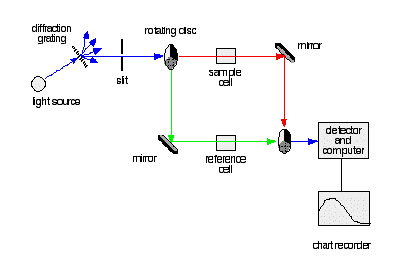UV – VIS SPECTROPHOTOMETER
- Make
LABINDIA INSTRUMENTS Pvt. LTD. - Model
LABINDIA UV- 3000+ - Specifications
Double Beam with Photo silicon Diode Array System.
Variable Slit width 0.5 to 5 nm
Automatic 8-Cell Changer
Wavelength range 190 to 1100nm
Photometric mode includes Analysis of Transmittance, Absorption, Energy and Concentration analysis.
UV-WIN Software Operational modes includes
a) Standard Photometric
b) Quantitative
c) Spectrum Scan
d) Kinetics (Enzymatic) Studies
e) DNA and Protein Analysis
Description
Many chemical species absorb light in either the visible or ultra violet region of the electromagnetic spectrum. This absorption is caused by the changing electron energy levels in the molecule and is therefore characteristic of the molecular structure. The technique is particularly useful for performing rapid quantitative concentration measurements of organic species in solution. Ultraviolet and Visible (UV-Vis) absorption spectroscopy is the measurement of the attenuation of a beam of light after it passes through a sample or after reflection from a sample surface.

The light source is usually a deuterium discharge lamp for UV measurements and a tungsten-halogen lamp for visible and NIR measurements. The instruments automatically swap lamps when scanning between the UV and visible regions. The wavelengths of these continuous light sources are typically dispersed by a holographic grating in a single or double monochromator or spectrograph. The spectral band pass is then determined by the monochromator slit width or by the array-element width in array-detector spectrometers. Spectrometer designs and optical components are optimized to reject stray light, which is one of the limiting factors in quantitative absorbance measurements. The light beam is redirected automatically to the appropriate detector when scanning between the visible and NIR regions.
Working Principle

Double Beam Optics with holographic grating in Czerny-Turner mounting Monochromator
Wavelength Ranges from 190 to 1100 nm .
High Sensitivity matched pair SILICON Photodiode Detector.
Scanning speed : 400 nm
High intensity Tungsten Halogen and Deuterium lamp with automatic changeover.
Multi-wavelength photometry and Multi-channel measurement.
UV-Vis spectrophotometers have extensive applications in the fields such as Chemicals, Pharmaceutical, Biotechnology, Environmental, Clinical & Food, Beverages, etc.
UV/VIS Spectrophotometers are able to carry out Photometric measurement, Spectrum scans, Kinetic measurements, Qualitative determination and DNA/RNA analysis.
Environmental applications include Monitoring of water quality, atmospheric pollution, rainfall and soil contamination.
Determination of metallic elements and inorganic salt in minerals for Geological exploration.
It can be applied for agricultural analysis such as pesticide detection, crops analysis, animal medicine analysis, fertilizer inspection, soil analysis, animal food stock inspection etc.
Analysis of additives preservatives and flavoring agents, minerals, vitamins.
Test micro samples of life science and provide DNA/Protein detector to measure the DNA/Protein concentration.
Qualitative and Quantitative measurement of various chemical species.
Sample required is 10ml. solution or 5 - 100 mg in solid state. Solvents should be specified for solution studies.
The absorption and emission by samples in the ultraviolet and visible region due to electronic transitions are measured. Electronic transitions depend on the environment of the sample
